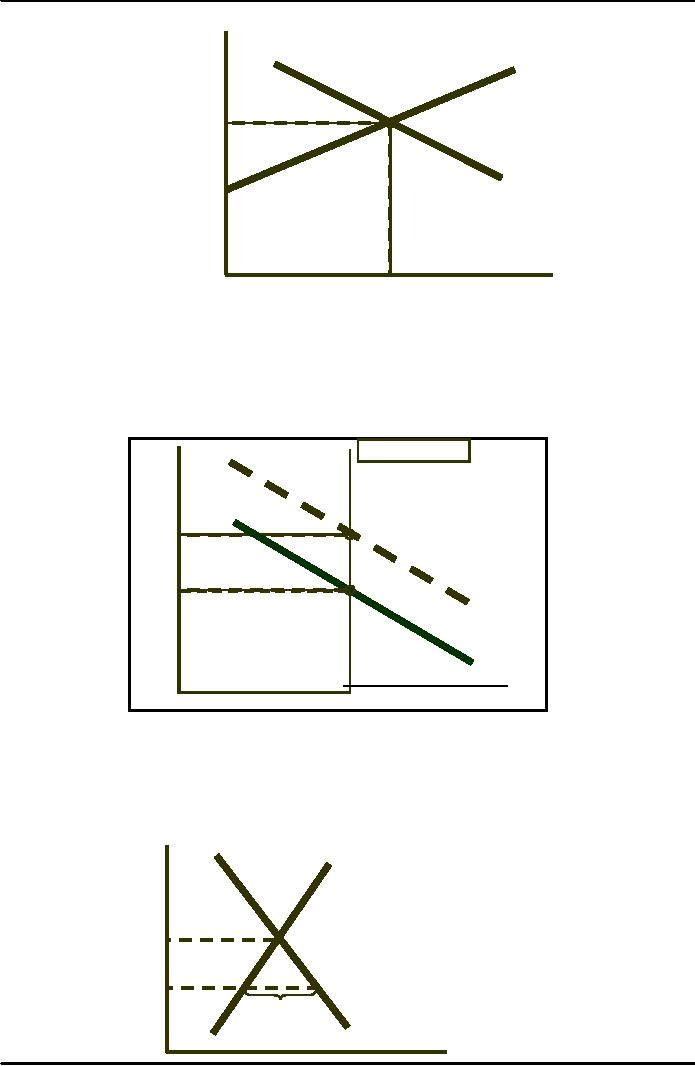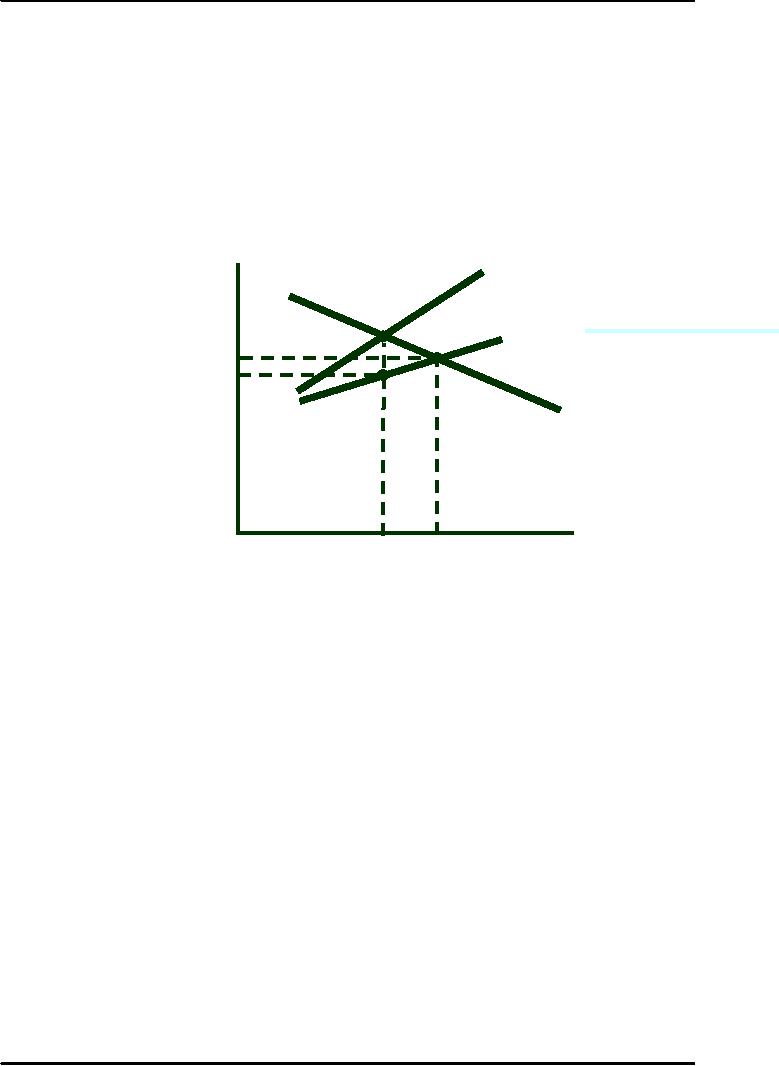 |
Equilibrium in a Competitive Factor Market:Labor Market Equilibrium |
| << Competitive Factor Markets:The Demand for Jet Fuel |
| Factor Markets with Monopoly Power:Monopoly Power of Sellers of Labor >> |

Microeconomics
ECO402
VU
�
Lesson
44
Equilibrium
in a Competitive Factor
Market
A
competitive factor market is in
equilibrium when the price
of the input equates the
quantity
demanded
to the quantity
supplied.
Labor
Market Equilibrium
Wage
Wage
Competitive
Output Market
Monopolistic
Output Market
SL =
AE
SL =
AE
v
w
B
w
A
P
* MPL
DL =
MRPL
DL =
MRPL
L
L
Number
of Workers
Number
of Workers
Equilibrium
in a Competitive Output
Market
DL(MRPL)
= SL
wC =
MRPL
MRPL =
(P)(MPL)
Markets are
efficient
Equilibrium
in a Monopolistic Output
Market
MR < P
MRP = (MR)(MPL)
Hire
LM at wage
wM
vM = marginal
benefit to consumers
wM = marginal
cost to the firm
Profits
maximized
Using less
than efficient level of
input
Economic
Rent
For a factor
market, economic rent is the
difference between the
payments made to a
factor
of production and the
minimum amount that must be
spent to obtain the use
of
that
factor.
199

Microeconomics
ECO402
VU
Wage
The
economic rent associated
with the
employment
of labor is the excess of
wages
paid
above the minimum amount
needed
to
hire workers.
SL =
AE
A
Total
expenditure (wage)
paid
w*
is
0w* x AL*
Economic
Rent
DL =
MRPL
B
Economic
rent is ABW*
0
L*
Number
of Workers
Question
What would be
the economic rent if SL is
perfectly elastic or perfectly
inelastic?
Land:
A Perfectly Inelastic
Supply
With land
inelastically supplied, its
price is determined entirely by
demand, at least in
the
short
run.
Land
Rent
Supply
of Land
Price
($
per
acre)
s2
Economic
Rent
s1
Economic
D2
Rent
D1
Number
of Acres
Pay
in
the
Public
Sector
The
percentage of personnel working in
public sector has been
declining
Shortages
of skilled personnel has
occurred? Why?
If there is a
shortage, the wage must be
below the competitive wage
rate
The
Shortage of Skilled
Personnel
S
Wage
w*
w
Shortage
DL =
Number
of Skilled Workers
200

Microeconomics
ECO402
VU
Public
sector pay is based on years
of service not MRP.
MRP
increases and the private
sector pay is greater than
public sector pay.
Many
leave the public
sector.
Factor
Markets with Monopsony
Power
Assume
The output
market is perfectly
competitive.
Input market is
pure monopsony.
Marginal
and Average
Expenditure
Why
is marginal expenditure
Price
Marginal
greater
than SL?
20
(per
unit
Expenditure
(ME)
of
input)
SL =
Average
C
Expenditure
(AE)
15
wc
w*
= 13
10
D
= MRPL
5
0
1
2
3
4
5
6
Units of Input
Lc
L*
Factor
Markets with Monopsony
Power
Examples
of Monopsony Power
Government
�
Soldiers
�
Missiles
�
B2
Bombers
NASA
�
Astronauts
Company
town
Monopsony
Power in the Market for
Baseball Players
Baseball
owners created a monopsonistic
cartel
Reserve clause
prevented competition for
players
1969--Average
salary was $42,000
1997--Average
salary was $1,383,578
1975 salaries
were 25% of team
expenditures
1980 salaries
were 40% of team
expenditures
201
Table of Contents:
- ECONOMICS:Themes of Microeconomics, Theories and Models
- Economics: Another Perspective, Factors of Production
- REAL VERSUS NOMINAL PRICES:SUPPLY AND DEMAND, The Demand Curve
- Changes in Market Equilibrium:Market for College Education
- Elasticities of supply and demand:The Demand for Gasoline
- Consumer Behavior:Consumer Preferences, Indifference curves
- CONSUMER PREFERENCES:Budget Constraints, Consumer Choice
- Note it is repeated:Consumer Preferences, Revealed Preferences
- MARGINAL UTILITY AND CONSUMER CHOICE:COST-OF-LIVING INDEXES
- Review of Consumer Equilibrium:INDIVIDUAL DEMAND, An Inferior Good
- Income & Substitution Effects:Determining the Market Demand Curve
- The Aggregate Demand For Wheat:NETWORK EXTERNALITIES
- Describing Risk:Unequal Probability Outcomes
- PREFERENCES TOWARD RISK:Risk Premium, Indifference Curve
- PREFERENCES TOWARD RISK:Reducing Risk, The Demand for Risky Assets
- The Technology of Production:Production Function for Food
- Production with Two Variable Inputs:Returns to Scale
- Measuring Cost: Which Costs Matter?:Cost in the Short Run
- A Firm’s Short-Run Costs ($):The Effect of Effluent Fees on Firms’ Input Choices
- Cost in the Long Run:Long-Run Cost with Economies & Diseconomies of Scale
- Production with Two Outputs--Economies of Scope:Cubic Cost Function
- Perfectly Competitive Markets:Choosing Output in Short Run
- A Competitive Firm Incurring Losses:Industry Supply in Short Run
- Elasticity of Market Supply:Producer Surplus for a Market
- Elasticity of Market Supply:Long-Run Competitive Equilibrium
- Elasticity of Market Supply:The Industry’s Long-Run Supply Curve
- Elasticity of Market Supply:Welfare loss if price is held below market-clearing level
- Price Supports:Supply Restrictions, Import Quotas and Tariffs
- The Sugar Quota:The Impact of a Tax or Subsidy, Subsidy
- Perfect Competition:Total, Marginal, and Average Revenue
- Perfect Competition:Effect of Excise Tax on Monopolist
- Monopoly:Elasticity of Demand and Price Markup, Sources of Monopoly Power
- The Social Costs of Monopoly Power:Price Regulation, Monopsony
- Monopsony Power:Pricing With Market Power, Capturing Consumer Surplus
- Monopsony Power:THE ECONOMICS OF COUPONS AND REBATES
- Airline Fares:Elasticities of Demand for Air Travel, The Two-Part Tariff
- Bundling:Consumption Decisions When Products are Bundled
- Bundling:Mixed Versus Pure Bundling, Effects of Advertising
- MONOPOLISTIC COMPETITION:Monopolistic Competition in the Market for Colas and Coffee
- OLIGOPOLY:Duopoly Example, Price Competition
- Competition Versus Collusion:The Prisoners’ Dilemma, Implications of the Prisoners
- COMPETITIVE FACTOR MARKETS:Marginal Revenue Product
- Competitive Factor Markets:The Demand for Jet Fuel
- Equilibrium in a Competitive Factor Market:Labor Market Equilibrium
- Factor Markets with Monopoly Power:Monopoly Power of Sellers of Labor